Florida Trees and Shrubs
Trees index / Page 1 of 11 pages
In addition to more than 300 native tree species, there are also many non-native trees, shrubs, vines, and herbs that have escaped from cultivation and now flourish in the sub-tropical Florida climate.
Many imported exotic plants quickly become invasive, noxious weeds that displace native plant species. Native wildflowers, shrubs and trees disappear and so do native animal species that have evolved along with them. Dependent on these specific plants for food, nesting or shelter entire ecosystems are damaged or completely destroyed as native animals - from bees, butterflies and other insects that in turn are prey for the birds, fish, reptiles, amphibians as well as the larger animals higher on the food chain all disappear along with their food sources.
Tree, shrub or herb - what's the difference?
A tree is defined as a single stemmed, woody plant with a distinct canopy or crown having a mature height of 15 feet or more.
Shrubs have multiple woody stems and they rarely or never exceed 13 to 15 feet when fully grown; some plants may grow either as a small tree or large shrub.
Herbaceous plants have very little or no above ground woody tissue/stems. Forbs, Graminoids and Ferns are all herbaceous in nature. Wildflowers, grasses and grass-like plants are examples.
On this page - Slash pine, Sand pine, Longleaf pine, Turkey oak, Myrtle oak, Laural oak, Live oak, Dwarf live oak, Sand live oak, Overcup oak, Florida poisonwood, Australian pine, Winged sumac, Swamp mahogany
Slash Pine, Yellow Pine - Pinus elliottii var. elliottii
Family - Pinaceae
Native
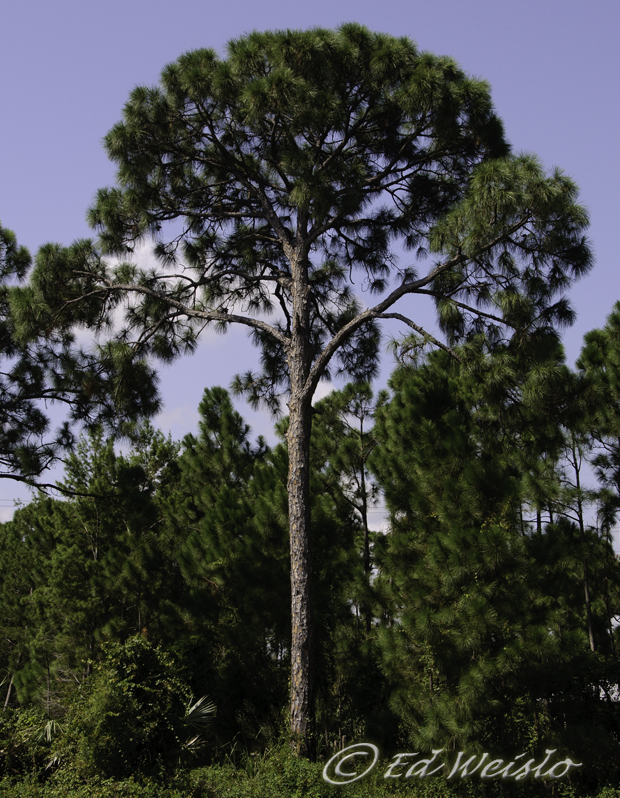
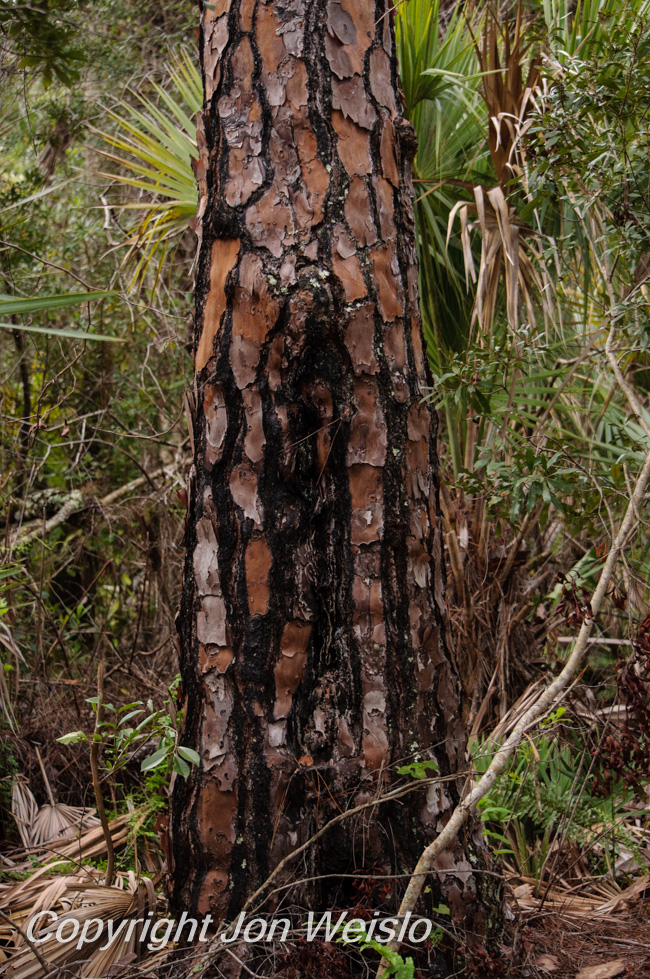
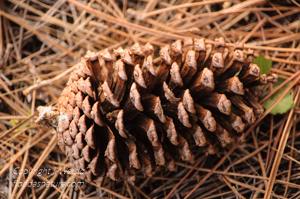
Slash pine is a large fast growing native evergreen conifer found throughout Florida that can attain 75 - 100 feet in height and a 3 to 4 ft. diameter trunk. Bald eagles nest in large slash pines, and seeds from cones are a food source for squirrels, wild turkey as well as white-tailed deer.
This is and has been a valuable natural resource for Florida. Early pioneers cut slashes in the trunk to collect the pine resin to produce turpentine, hence the common name of slash pine. During the era of wooden ships the U.S. Navy also employed thousands of workers to collect and process this resin into waterproofing material. Today millions of slash pines are planted each year to replace those harvested for lumber, pulp wood and rosen.
Slash pine has a straight trunk, the grey scaly bark has large orange-brown plates and is deeply fissured. The cones are 3 - 6 inches in length and to 3 inches in diameter with fine prickles on the tips of the scales. Needles are 8 -12 inches long, 2 or 3 per fascicle (bundle). Crown is open, irregular, oval to pyramidal with ascending branches. Slash pine grows in well drained to wet sandy acidic soils and will tolerate moderate seasonal flooding once established.
Slash pine can live to be around 200 years old, and it is well adapted to wildfires, the thick scaly bark protecting it from most fires.
Naturally occurring periodic wildfires or controlled burns are important to clear out the accumulation of debris such as fallen trees and branches, leaves and pine needles. Because slash pine needs open areas with bright sun to germinate, in areas where fire has been suppressed or have not burned for a prolonged period slash pine is gradually replaced by mixed hardwoods on drier sites or bayheads on wetter areas.
Sand Pine - Pinus clausa
Family: Pinaceae
Native
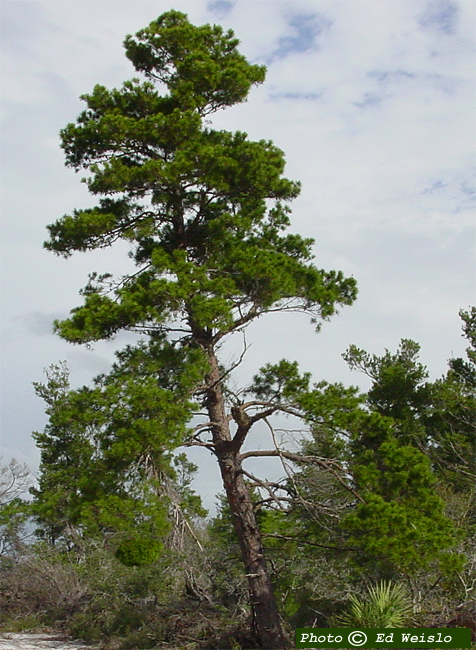
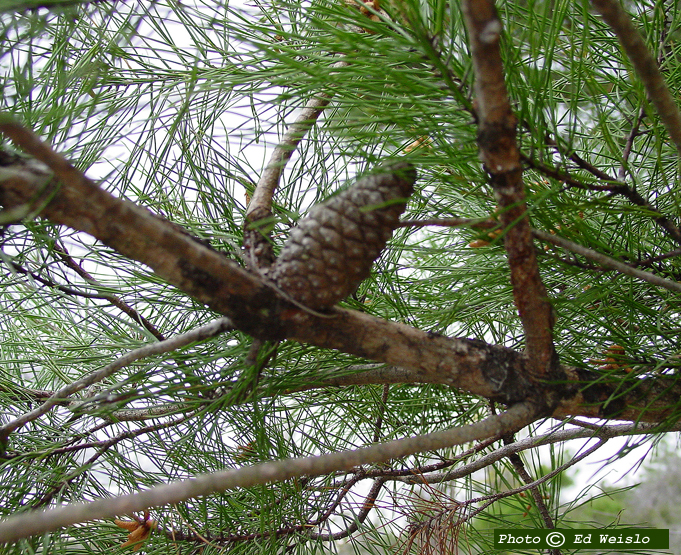
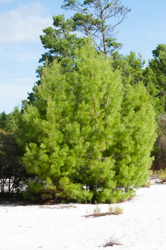
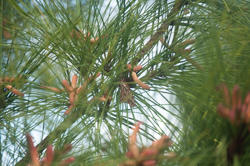
Found on dry sandy ridges, open upland forests on well drained white or yellow acidic soils. Sand pine is an evergreen conifer and may be the only canopy tree present in scrub habitat occurring in combination with other tough drought tolerant plants such as Florida rosemary (Ceratiola ericoides) that require little in the way of nutrients or moisture.
This Florida native may grow 80 to 90 feet tall although it is more common at 15 to 30 feet. While sand pine is not used as lumber like its cousin the slash pine (rarely having a straight trunk of any significant length) it is grown as a source of pulpwood. The open crown of a mature tree may be rounded or flattened, the bark is smooth and gray when young, becoming thick, scaly and reddish-brown with age. Cones are closed, 1 - 3 inches in length that may persist on the tree for years, even becoming embedded in the twigs on which they grow. Turkey, squirrels and other small animals eat the seeds.
Two geographic varieties are generally recognized, Pinus clausa var. clausa (Ocala variety) occurs throughout most of the state and produces waxy, serotinous cones which may remain closed for years only opening after a fire, although occasionally the very high summer temperatures on the surface of the sand will cause them to open. Because they need open spaces with direct sunlight for their seedlings to grow, sand pine has adapted to regular cycles of fire that burns off undergrowth and accumulated detrius thus allowing enough sunlight through to the ground to produce a new generation of pines.
P. clausa var. immuginata (Choctawhatchee variety) ranges from northwestern Florida into southeastern Alabama produces open, non-serotinous cones.
Longleaf pine - Pinus palustris
Family - Pinaceae
Native
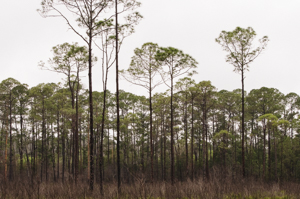
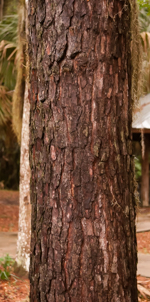
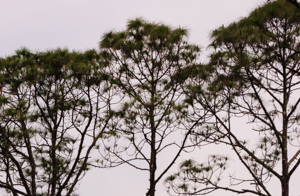
The native longleaf pine can reach a height over 100 feet with a trunk diameter of 46-47 inches, although it is usually seen much smaller in stature, as extensive logging has removed the older, mature trees that can take 150 years to reach full maturity.
This tree has a straight trunk with orange-brown, bark that forms irregular, rectangular, scaly plates; bark color is browner with age. Crown is open with spreading, ascending branches, curved upward at the tips.
Leaves (needles) are 6-12 inches long held in fascicles (bundles) of 3 sometimes 2 needles. New buds or "candles" are 3-15 inches long and silvery in color. Cones are near branch tips, are sessile or nearly so and take two years to mature.
Longleaf pine is an important tree economically as it is tapped for turpentine, used for its pitch and for lumber, it is an important wildlife food source and longleaf pine forests are the habitat for a wide variety of animals.
Australian Pine - Casuarina equisetifolia
Family - Casuarinaceae
Invasive / Exotic

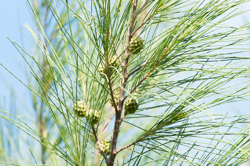
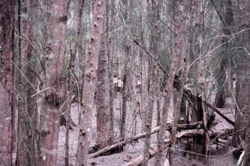
Common names include coastal she-oak, horse tail she-oak.
Australian "pines" are not in the genus Pinus and are not true pine trees, there are three species Casuarina present in Florida, of these there are also sub-species as well as hybrids between the three species. This tree is listed as a category 1 invasive plant and it is actually illegal to plant this tree in many parts of Florida.
Once commonly used as a landscape tree and windbreak it is now a common sight in south Florida, particularly on beach dunes and the shorelines of brackish and fresh waterways. Australian pine "needles" are actually segmented branch-lets, the actual leaves are very tiny, scale-like and are produced in whorls at the joints of these branch-lets, the fruit slightly resembles a "cone" however these trees are not conifers.
These trees can attain a height greater than 100 feet, forming dense thickets thus crowding out native plants, like some other exotic plants it also produces compounds which prevent other plants seeds from germinating, in the picture above right the thick carpet of leaf litter can be seen with no under-story plants growing, Australian pine contributes nothing to native animals and destroys natural habitat by producing these monocultures thickets.
Turkey oak - Quercus laevis
Family - Fagaceae (Beech Family)
Native
 Leaf detail_small.jpg)
 bark detail_small.jpg)
Grows in dry, sandy soils of ridges, may mixed with dry pine flatwoods to a height of 20-50 feet. A relatively short lived, fast growing tree. Turkey oak acorns require two years to mature and are an important wildlife food source browsed by deer, bear and turkey. Leaves have 3 to 7 deep lobes, resembling the shape of a turkeys foot for which this tree was given its common name.
Myrtle Oak - Quercus myrtifolia
Family - Fagaceae
Native
_small.jpg)
_small.jpg)
Scrub, coastal hammocks & dunes, on deep sandy soils
May grow as a tree to near 40 feet in height, more commonly growing as a shrub in tangled thickets with contorted trunks. Leaves are 1 - 2 inches long, alternately arranged, with a smooth leathery upper surface and yellowish to rust colored underside, margins of leaves are usually turned under.
Live oak - Quercus virginiana
Family - Fagaceae
Native



Family - Fagaceae
Habitat - Coastal hammocks, Maritime Forests, Inland Hammocks, Hardwood Swamps on sandy, moist soils.
Broad crown with a stout trunk to more than 4 feet in diameter and very large, low, spreading branches. Live oak can grow to 80 feet tall with an equal or greater spread.
Leaves are alternate, are elliptic to obovate in shape with slightly wavy, entire margins, leathery, dark green & shiny on upper surface, pale green and pubescent on bottom surface.
Live oak was once an important source of strong wood for ship builders that would search out and harvest trees with branches shaped as needed for a ships ribs and timbers. The Live oaks acorns are an important food source for many animals and birds and the tree itself provides habitat and nesting sites for the Florida scrub jay.
Laurel Oak - Quercus laurifolia
Family - Fagaceae
Native

_small.jpg)
Habitat - Wet to dry sites, swamps, bottom lands, river floodplains, wet flat-woods.
Tree to 60 plus feet in height, with a dense, symmetrical, oval to rounded crown & a trunk that can be up to 4 feet in diameter. Leaves are 2 - 4 inches long, alternate, simple, smooth, entire or parted, varied form; elliptic, oblanceolate, obovate, some with a distinct diamond shape. Spring flowers are an inconspicuous brown catkin. An attractive fast growing tree widely used in both commercial & residential landscapes.
Dwarf Live Oak - Quercus minima
Family - Fagaceae
Native
_small.jpg)
2_small.jpg)
_small.jpg)
Habitat - Pinelands, Scrubby flatwoods, Wet flatwoods, Sandhill
Native low growing shrub, sub-shrub, rarely exceeding 3 feet, common at 16-18 inches or less.
Leaves alternate, simple, evergreen, leathery, variable size and shape, 1 to 4 inches long, shiny green above, lower surface (usually) pubescent.
Flower - Early spring, Male- Yellow-green catkins 2-3 inches long, Female - small, inconspicuous in leaf axils.
Sand Live Oak - Quercus geminata
Family - Fagaceae
Native

Habitat - Scrub, Coastal Hammocks & Dunes, Sandhill
Growth habit may be as a large shrub to a medium sized tree, usually with contorted, twisted trunks. Open canopy, somewhat sparsely branched. Leaves are alternate, thick and leathery with rolled under, entire margins.
Overcup oak - Quercus lyrata
Family - Fagaceae
Native

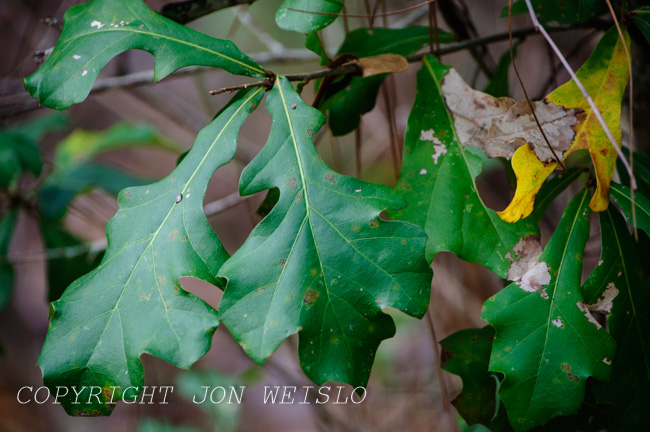
Native tree in the white oak sub-group, capable of 100 plus foot growth, more common in the 35 - 40 foot height range with an approximate equal spread.
Bark is light gray and fissured with scaly plates at maturity. Leaves are 5 1/2 to about 9 inches long with entire margins, having 5–9 deep lobes, shiny dark green above, gray-green below. Overcup oak is named for the half-inch to 1 inch long acorns that are 2/3 or nearly enclosed by the "cup".
Turkey, feral hogs, white-tailed deer, squirrels and other rodents eat the acorns. This tree is found growing on river floodplains, bottomland forests and the margins of swamps.
Florida Poisonwood - Metopium toxiferum
Family - Anacardiaceae
Native
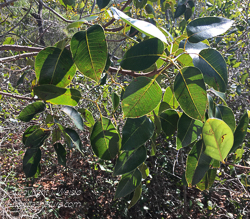
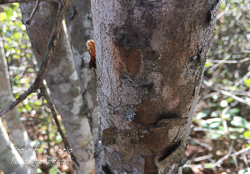
Related to the Poison Oak and Poison Sumac, the sap of the Florida Poisonwood tree contains strong alkaloids that cause serious skin and mucus irritations. Common throughout the Florida Keys and on or near saltwater shorelines and sand dunes, Pine rocklands and coastal hammocks.
Poisonwood is an evergreen shrub or medium sized tree 25 - 35 feet or taller, has a short trunk with drooping branches and a spreading, rounded crown. Poisonwood may grow as a shrub or tree.
Bark is reddish-brown or grey with black splotches of sap, older trees develop scaly bark, leaves are odd-pinnately compound, alternately arranged, 6-10 inches long with 3 to 7 (usually 5) oval to elliptical leaflets, leaflets are smooth glossy green above - paler underneath often with spots of black resin.
Winged Sumac - Rhus copallinum
Family - Anacardiaceae
Native
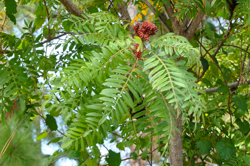
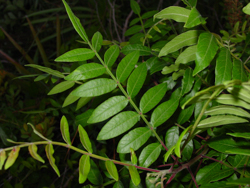
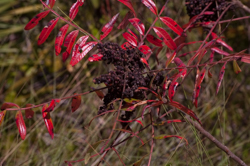
Common names include - Shining sumac, flameleaf sumac, dwarf sumac
Large deciduous shrub or small tree 18 feet or occasionally taller with a more or less equal spread, trunk may be up to 10 inches in diameter but usually much smaller, the bark is smooth, light brown and becomes scaly with age, crown is irregular and of medium density.
Leaves are dark green turning bright red in the fall. Leaves are arranged alternately, up to 8-12 inches long, odd-pinnately compound, individual leaflets are oblong lanceolate 2-4 inches long with entire margins.
Panicles made up of many small, greenish-yellow flowers are produced in the summer, individual plants produce either all male or all female flowers.
Fruit is a red fleshy berry eaten by many birds and other animals. Deer and rabbits also feed on bark and twigs. Winged sumac grows in the dry to moist sandy soils of pinelands.
Swamp Mahogany - Eucalyptus robusta
Family - Myrtaceae
Exotic / Naturalized
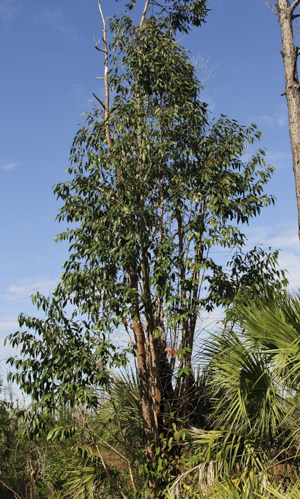
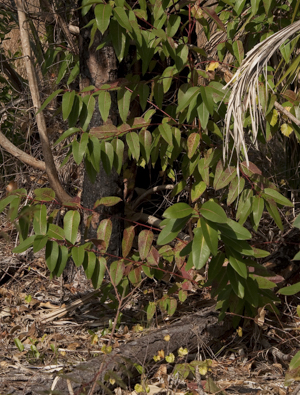
Native range is a small area along the Australian coast of New South Wales and southeast Queensland, its native habitat is the flood plains of protected coastal areas, lagoons, and swamps. It is naturalized in southern Florida.
Swamp mahogany is a long lived fast growing tree that can be up to 98 feet tall with a 65 foot canopy spread. The bark is rough, thick, coarse, soft and spongy, deeply furrowed and grey or reddish grey.
Leaves are broadly lanceolate to ovate, 3 1/2-6 1/2 inches long, alternate, and leathery.